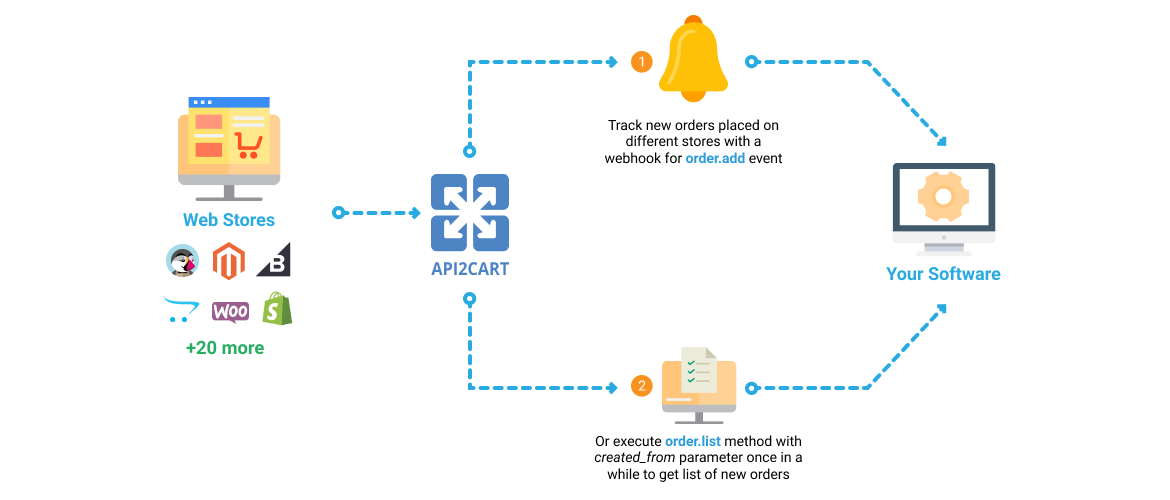
The size of the eCommerce market is expanding every day. Growing retail businesses are looking for a tool that can simplify their warehouse operations. In such a scenario, a solution like WMS (warehouse management system) serves a great deal. WMS monitors and controls all the warehouse operations starting from receiving products to delivering them to the end-customers. Some of them include fulfilling orders, tracking shipments, managing stock levels, and updating order statuses.
To perform these tasks seamlessly, WMS needs to be integrated with marketplaces and shopping platforms, where online retailers build their online stores. It allows the store owners to track the right info about the orders and shipping, and give accurate updates to their customers.
Usually, vendors choose popular shopping platforms like Magento for their stores' creation. That is why Magento integration with warehouse management systems is the number one task for providers of such kind of software. Without such a connection, WMS systems providers can not provide their solutions to e-retailers who have their stores on Magento.
Let's dive deeper into the unknown realities of Magento WMS integration and find out how to develop it easily and quickly.
Top 5 Facts about Magento WMS Integration
- Integration with Magento can expand the number of your WMS clients
- Integration with Magento can increase your market presence
- Magento integration allows access to all needed data
- Magento WMS Integration development is a challenging and technologically complex task
- The development of integration is a time-consuming process
Integration with shopping platforms offers one thing for sure - an increased number of clients. For example, more than 300,000 online shops are built on Magento. So, if you develop WMS integration with Magento, you can get access to these shop owners and make them your customers. It means that Magento retailers can use your software easily because of your connection with this platform.
To make your warehouse management software more successful, you need to improve your market presence. Magento integration with warehouse management systems allows you to do this in a streamlined way. 1.2% of the Internet is powered by Magento. Also, it has excellent clientele in the USA. Approximately more than 11% of all the USA websites are using this shopping platform. Western Europe, Russia, India, South America, and Africa are also among the top locations where Magento is popular.
These figures indicate a significant market presence that Magento experiences. That is why Magento integration is vital for you in case you want to increase your market share.
Moreover, a significant number of prospective clients and the fantastic popularity between online retailers from all of the world allows you to increase your WMS solution profits dramatically.
Magento integration with the warehouse management system is an essential aspect that allows this software to perform all the critical operations smoothly. Based on this connection, WMS solutions can manage the info about orders, products, customers, etc., from online stores built on Magento. Without that, such systems can’t provide their critical functions like product tracking, ensuring accuracy and speed of order fulfillment, inventory updating, and generating up-to-date reports to the Magento users.
Like every other integration process, Magento integration with the warehouse management system is equally tedious and challenging. First of all, it is really hard to find a developer with advanced web programming skills and technical expertise. Apart from this, the developers’ salary around the world ranges from 3000 to 6000$/month. So, this process can be really expensive in perspective.
There are several technical issues that can be encountered while developing integration with Magento. They include issues connected with sending information to Magento, inaccuracy of its API documentation, reindexing process troubles, etc.
Most importantly, every integration needs updates and maintenance after coming into practice. It also would include additional costs.
Every development of connection with shopping platform takes time, and the same is the case with Magento integration with warehouse management systems. Integrating your WMS with Magento would make you wait for an expected duration of 8 weeks. Understanding the tech aspects of this platform consumes significant time.
The database model of Magento, EAV (Entity - Attribute - Value) uses more than 40 tables to store product and category data. The complexity increases while extracting data and hence, leads to more time consumption. The poor performance of Magento API is another pain point for developing the integration. In the case of large volumes of data, the database may even lock and lead to failure in updates.
How to Connect your WMS to Magento Easily?
Magento integration with warehouse management systems indeed offers a lot of privileges. Having said that, the other side of the coin cannot be ignored. Integration with Magento is not a piece of cake as it seems to be. Programmed with high technical skills and expertise, Magento is very challenging to integrate with.
API2Cart allows you to avoid all the pitfalls of Magento integration. API2Cart provides a unified API and powers connection with 40+ eCommerce platforms like Shopify, eBay, WooCommerce, BigCommerce, etc. including Magento. Comprehensive technical support and detailed API docs make the process of integration even more straightforward.
API2Cart provides the following API methods for working with Magento e-stores' data:
- for working with products:
- product.info - to retrieve product details
- product.count - to count the number of orders
- product.add/list/update - to add/update products and their lists
- for working with orders:
- order.add/list/update - to add/update orders and their lists
- order.info - to retrieve order details
- order.find - to search requested customer orders list
- order.shipment.tracking.add - track delivery and shipment status
- for working with customers:
- customer.info - to retrieve details connected with customers
- for working with categories:
- category.list - to retrieve the category list from the store
- category.info - to retrieve information about categories
How to Import Orders from Magento e-Stores into Your WMS?
Let's explore how you can import the order data from the online stores based on Magento using API2Cart API methods.

To perform such a kind of operation, you can perform a webhook for order.add event or order.list method. The usage of the webhook for order.add event allows you to get notifications every time the new order is placed on the Magento store. Webhooks enables you to decrease the server load, saves API requests, and provides more up-to-date info.
The usage of order.list method provided by API2Cart makes it possible for you to retrieve the list of orders and import them into your system with no difficulties. Moreover, you'll be able to filter the orders by specific parameters. For example, you can filter them by their creation or modification date.
With API2Cart, you can resolve a significant amount of your tasks related to the Magento WMS integration. To know more about how API2Cart works, you can schedule a call with our consultant and try the service for 30-days absolutely for free.



